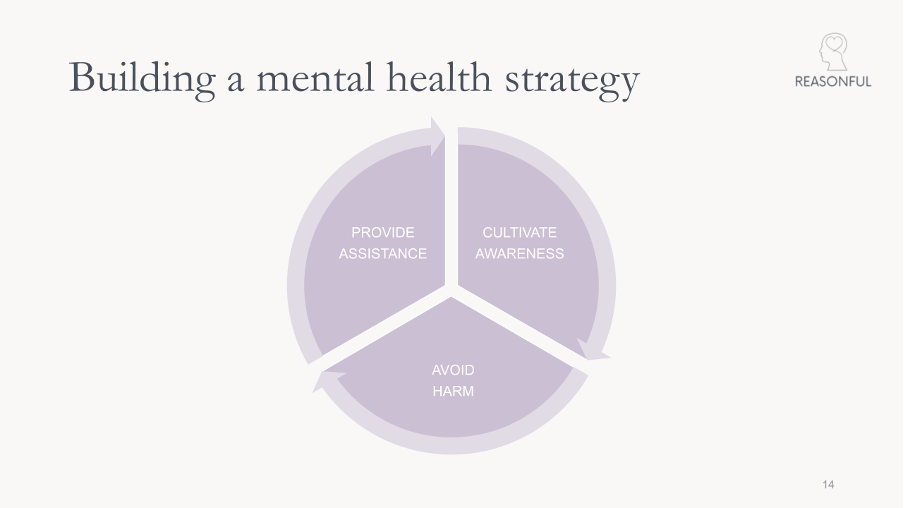Building a wellbeing strategy: a blueprint for a happier and healthier workplace
Did you know that it has been estimated that the average person will spend one-third of their life at work? That’s roughly 90,000 hours at work over your lifetime.
With such a significant amount of our lives spent at work, workplaces play an integral role in an employee's wellbeing which is why it’s so important for organisations to have a wellbeing strategy in place.
First of all, what’s a wellbeing strategy?
“An employee wellbeing strategy is a company strategy or program that specifically focuses on the physical health, mental status, and financial wellbeing of its employees.” - Work Human (August 2023).
Typically encompassing a range of initiatives and programmes, a wellbeing strategy is designed to support individuals in achieving optimal wellbeing, both inside and outside the workplace.
From promoting work-life balance to providing access to mental health resources, a wellbeing strategy addresses various facets of wellness to create a supportive and nurturing environment for all employees.
Work Human articulate it well in their blog: “A well-executed employee wellbeing strategy takes on a prevention-over-cure approach, meaning that it addresses risk factors in the work environment before they happen.”
Saying that, I believe that supporting employees with wellbeing issues as they arise is still an important part of strategy, but not the only part.
Why does your organisation need a wellbeing strategy?
Well… here are a few key stats:
1 in 4 adults are affected each year by mental illness in the UK.
1 in 5 in the US and 1 in 8 worldwide
When you include those indirectly impacted by mental illness, it looks more like 9 in 10
Mental health problems on average cost companies £56 billion per year (Deloitte, 2022).
In 2023, UK employees were absent an average of 7.8 days over the past year. This is the highest level reported in over a decade (CIPD, 2023).
Over 76% of respondents reported stress-related absence in their organisation in the past year (CIPD, 2023).
Stress, anxiety or depression now account for 19.6 million working days lost in the UK (HSE, 2020).
And, with the rise of remote work, flexible schedules, and global teams, employers face new challenges related to work-life balance, isolation, and stress.
These stats represent just the tip of the iceberg. Significant data is highlighting the many mental health crises we’re having in the UK and the domino effect it has on businesses.
So, what are the workplace benefits of having a wellbeing strategy in place?
This work can be hard, it’s not always sunshine and rainbows. It can be tricky prioritising this when budgets are tight and other business objectives require your attention. However, having a wellbeing strategy in place can have a significant positive impact on both individual employees and the workplace as a whole.
And this can lead to…
Employee health and productivity improvements - When employees feel healthy and balanced they can be more productive, engaged, and resilient. This can lead to better performance and reduced absenteeism.
A supportive and positive work culture - Prioritising wellbeing demonstrates that the organisation cares about its employees beyond just their productivity. This can lead to increased morale and motivation.
The attraction and retention of talent - A robust wellbeing strategy can be a significant differentiator in attracting top talent and retaining current employees.
Cost savings - Investing in employee wellbeing can result in long-term cost savings for organisations. This can decrease recruitment and training expenses, mitigate the impact of absenteeism and presenteeism, and MORE.
Positive reputation - Demonstrating a commitment to employee wellbeing aligns with broader social responsibility initiatives. It reflects positively on the organisation's brand and reputation, both internally among employees and externally with customers, investors, and the community.
But how do we get there?
Building a mental health strategy
Here are three important foundations to any wellbeing strategy:
Cultivate awareness - prioritise mental health awareness training, particularly among leadership teams, and encourage ongoing communication and actions related to wellbeing throughout the organisation.
Avoid harm - Foster a culture of inclusion that actively works to prevent harm to mental health. Utilise self-help tools and practices to continually assess and address potential areas of harm.
Provide assistance - Ensure that employees facing health and wellbeing challenges receive the necessary support. Provide access to Employee Assistance Programs (EAPs), therapy resources, and Mental Health First Aiders (MHFAs) to facilitate holistic support for individuals navigating mental health difficulties.
Based on LaMontagne’s Integrated Intervention approach.
These are just the start and a wellbeing strategy isn’t simply a set of documented good intentions. Successfully introducing and implementing a wellbeing strategy requires energy, commitment, education and engagement if it is to become embedded in organisational culture.
If you’re looking to incorporate a wellbeing strategy into your workplace, you can get started today by signing up for our free Guide to Building and Sustaining a Culture of Wellbeing.
I’m Miriam and I run Reasonful - we offer support to small and medium-sized businesses that are typically facing challenges of rapid growth, talent retention, fast-paced work and constant pressure to deliver results, all whilst wanting to support long-term employee mental health and wellbeing.
We offer mental health workshops, mindfulness classes, wellbeing strategy support and bespoke programmes.
Sign up for our FREE Guide to Building and Sustaining a Culture of Wellbeing to get started today. Click here to find out more.
Or, book a no-obligation 20-minute call to learn more about unleashing your team's potential through strategic mental health initiatives here.


